Mostrar el registro sencillo del ítem
Critical review on the stability of illicit drugs in sewers and wastewater samples
| dc.contributor.author | McCall, Ann-Kathrin | |
| dc.contributor.author | Bade, Richard | |
| dc.contributor.author | Kinyua, Juliet | |
| dc.contributor.author | Lai, Foon Yin | |
| dc.contributor.author | Thai, Phong K. | |
| dc.contributor.author | Covaci, Adrian | |
| dc.contributor.author | Bijlsma, Lubertus | |
| dc.contributor.author | van Nuijs, Alexander | |
| dc.contributor.author | Ort, Christoph | |
| dc.date.accessioned | 2016-01-25T10:04:25Z | |
| dc.date.available | 2016-01-25T10:04:25Z | |
| dc.date.issued | 2015-10 | |
| dc.identifier.citation | McCall, A. K., Bade, R., Kinyua, J., Lai, F. Y., Thai, P. K., Covaci, A., ... & Ort, C. (2016). Critical review on the stability of illicit drugs in sewers and wastewater samples. Water research, 88, 933-947. | ca_CA |
| dc.identifier.uri | http://hdl.handle.net/10234/146505 | |
| dc.description.abstract | Wastewater-based epidemiology (WBE) applies advanced analytical methods to quantify drug residues in wastewater with the aim to estimate illicit drug use at the population level. Transformation processes during transport in sewers (chemical and biological reactors) and storage of wastewater samples before analysis are expected to change concentrations of different drugs to varying degrees. Ignoring transformation for drugs with low to medium stability will lead to an unknown degree of systematic under- or overestimation of drug use, which should be avoided. This review aims to summarize the current knowledge related to the stability of commonly investigated drugs and, furthermore, suggest a more effective approach to future experiments. From over 100 WBE studies, around 50 mentioned the importance of stability and 24 included tests in wastewater. Most focused on in-sample stability (i.e., sample preparation, preservation and storage) and some extrapolated to in-sewer stability (i.e., during transport in real sewers). While consistent results were reported for rather stable compounds (e.g., MDMA and methamphetamine), a varying range of stability under different or similar conditions was observed for other compounds (e.g., cocaine, amphetamine and morphine). Wastewater composition can vary considerably over time, and different conditions prevail in different sewer systems. In summary, this indicates that more systematic studies are needed to: i) cover the range of possible conditions in sewers and ii) compare results more objectively. To facilitate the latter, we propose a set of parameters that should be reported for in-sewer stability experiments. Finally, a best practice of sample collection, preservation, and preparation before analysis is suggested in order to minimize transformation during these steps. | ca_CA |
| dc.format.extent | 14 p. | ca_CA |
| dc.format.mimetype | application/pdf | ca_CA |
| dc.language.iso | eng | ca_CA |
| dc.publisher | Elsevier | ca_CA |
| dc.relation.isPartOf | Water Research Volume 88, 1 January 2016 | ca_CA |
| dc.rights | Copyright © 2015 Elsevier Ltd. All rights reserved. | ca_CA |
| dc.rights.uri | http://rightsstatements.org/vocab/InC/1.0/ | * |
| dc.subject | Transformation | ca_CA |
| dc.subject | Sewage epidemiology | ca_CA |
| dc.subject | Sample preservation | ca_CA |
| dc.subject | Psychoactive substances | ca_CA |
| dc.subject | Biodegradation | ca_CA |
| dc.title | Critical review on the stability of illicit drugs in sewers and wastewater samples | ca_CA |
| dc.type | info:eu-repo/semantics/article | ca_CA |
| dc.identifier.doi | http://dx.doi.org/10.1016/j.watres.2015.10.040 | |
| dc.rights.accessRights | info:eu-repo/semantics/openAccess | ca_CA |
| dc.relation.publisherVersion | http://www.sciencedirect.com/science/article/pii/S0043135415303055 | ca_CA |
| dc.type.version | info:eu-repo/semantics/submittedVersion |
Ficheros en el ítem
Este ítem aparece en la(s) siguiente(s) colección(ones)
-
IUPA_Articles [307]







